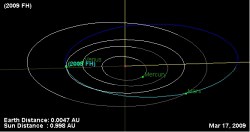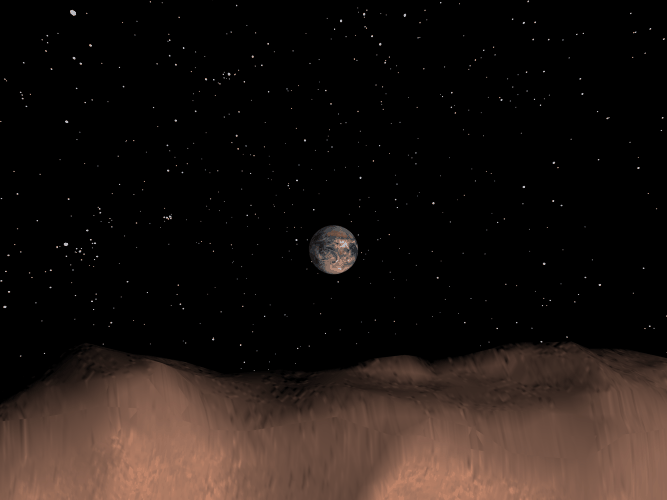[/caption]Another asteroid is set to make a close approach of 79,000 km according to NASA, a distance twice that of geosynchronous orbit around the Earth. Although the 15-20 metre-wide rock is not expected to cause any problems to Earth or satellites, some observers may be lucky to spot the faint light from 2009 FH as it passes.
Interestingly, this new object comes only two weeks after a larger (50 metre wide) asteroid was spotted passing the Earth at a similar distance. So it begs the question, why are we seeing so many asteroids lately?
“This asteroid flyby will be a good viewing opportunity for both professional and amateur astronomers,” said Don Yeomans from the Near-Earth Object Office at NASA’s Jet Propulsion Laboratory in Pasadena, California. “The asteroid poses no risk of impact to Earth now or for the foreseeable future.”
NASA is always very quick to point out these objects are harmless, passing the Earth at a very safe distance, often beyond the Moon’s orbit. However, 2009 FH will pass at a similar distance to the 50 metre-wide 2009 DD45 on March 2nd.

This discovery was made by NASA’s Near Earth Object Observation Program, known as Spaceguard, to detect and track potentially hazardous asteroids that stray close to the Earth. It appears the Spaceguard team are getting better and better at spotting these chunks of rock. Although it might seem there are a lot more asteroids than before, this isn’t the case, we’re just getting better at finding them.
Sources: NASA, Spaceweather.com


Are there any plausible methods of actively detecting near earth asteroids that will give us more than a few days warning of a possible impact? Something like a space borne radar satellite(s) to actively search for them?
Are we only relying on optical methods of finding these asteroids?
We have another recently discovered rock passing just a little further out this week. 2009 DO111, a 70m-170m discovered late February, will pass within just 1.2 LD on Friday morning (0400UTC). It will be visible at 13th magnitude in Ursa Major and Camelopardalis.
A colleague and I will try to feature live imaging sessions on Slooh, capturing it very close proximity to several nice galaxies including M81 and M82. We’ll also run a free internet radio stream for non-members to be able to listen to the action.
One has to wonder, are we simply better able to detect these objects, or are there really more of them lately. I’ve noticed in the past couple of years of following NEOs that we seem to get spurts like this at least a couple of times of years, so my question is, are they associated with each other, possibly remnants of distant or even recent main belt collisions.
“So it begs the question, why are we seeing so many asteroids lately?”
No – it begs the question, how many have we missed in the past because we were not looking?
See the links at:
http://users.tpg.com.au/users/horsts/spacegd.html
One third of the sky is not being routinely searched because of a lack of facilties and people in the Southern Hemisphere
Just to clarify for those new to astronomy – when I say “in close proximity”, I mean visually. The galaxies and or other deep sky objects we see these Near Earth Objects passing are actually many hundreds, thousands, and millions of light years distant.
Tavi;
I assume that by LD you mean “lunar distance” and not “light day” since 1.2 light days would not be close enough to bother mentioning.
“So it begs the question, why are we seeing so many asteroids lately?”
“No – it begs the question, how many have we missed in the past because we were not looking?”
::shouting at cold, uncaring Internet/universe::
It raises these questions, it doesn’t beg them!
::cries::
could comet lulin have disrupted a few asteroids as it flew near the asteroid belt ? how close did it fly by the belt and how large is the actual comet . just wondering . thanks
Comet Lulin is to low mass to be expected to have greatly altered any asteroid.
But “many rivers small”, asteroids and comets and most of all ofc the planets do gradually alter eachothers orbits, and sometimes the altered object gets to close to a larger object (planet or larger asteroid) and gets a drastically different orbit, even flung into the sun or flung out of the solarsystem.
“So it begs the question, why are we seeing so many asteroids lately?”
No – it begs the question, how many have we missed in the past because we were not looking?
Aahhhh! Begs the question does not mean “raises the question”!!
“Begging the question is a logical fallacy in which the proposition to be proved is assumed implicitly or explicitly in one of the premises.” -wikipedia
Example: “Why am I the boss? It’s because I call the shots around here.”
Begging the question means using circular logic by using proof that has the same inherent question as the original question.
Sorry, pet peeve.
Tavi,
If these asteroids have anything in common it could be that we are getting closer to the galaxy’s magnetic reconnection and from an idea of mine could posses many large sized asteroids left over from SGR.A creating this galaxy. I know that is conjecture but remember Cassini found that the rings of Saturn were older nearer to the planet then the rings further away, which supports this idea how matter is created on the magnetic reconnection of a stars magnetic field. The stronger the magnetic field becomes, over time, the further matter away is then created. This idea explains why all the planets in this solar system began forming on the sun’s magnetic reconnection when the sun was a giant planet itself, first creating rings then the rings collecting together to form planets. Exactly what is being observed around the outer planets, Saturn, Jupiter, Uranus, and Neptune. When these planets become stars, if the gravity increases from accreation, the moons will then be called planets.
If the asteroid were big enough and electrically charged it would disturb the Earth’s orbit and axis of rotation.
The Mayan Doomsday Prophecy is being fulfilled. A tiny stream of puny asteroids is being sent by Earth to cause trolling internet users death by multiple panic attacks culmulating on Dec. 21st, 2012.
The result? Peace and quiet on God’ green Earth. (Yawn)
The “50 metre wide” asteroid two weeks ago was actually only 19 meters. It’s size was overestimated because its albedo was underestimated.
Too bad we havn’t learned how to streer those things, we could land it midway between NY City and Wash DC and get two birds with one shot
@kts
Where does the mass come from, for any planet in the solar system te become heavy enough to start fusion?
@OillsMastery
They allready do disturb it, charged or not.
It is clear to any dunderhed what is happening. The Aliens, alerted by SETI are becoming scared of us and are practising hurling asteroids at us to firstly destroy us and then they can take over our nice blue green planet. Now, if we are clever and we can negotiate an agreement with these aliens and persuade them to aim a large asteroid at Olympus Mons on Mars then maybe the resultant release of gas and water could again make that planet habitable and we could all live peacefully together..
“Are there any plausible methods of actively detecting near earth asteroids that will give us more than a few days warning of a possible impact?”
Yes. Telescopes.
But there would have to be a number of them, in various locations, dedicated to nothing but searches for Near Earth Objects. The answer, as is often the case, finding the money for such an ongoing program.
In other words, it probably would mean increasing Spaceguard’s budget, allowing them more dedicated tools to work with…
We are entering an cyclical asteroid phase..(amongst others/warming,solar/gravity waves and gamma ray activity…near the galactic center)…nasa knows it that is why all the press on neo’s ….the ancients knew this……we are entering the freeway now…..
here’s another one for today……
2009 FK – intruder
Approximate diameter: 7 meters (H=28.349)
Closest Earth approach: 0.97 LD at 2314 UTC yesterday
Inside Earth-Moon system: 1954 UTC yesterday until 0235 UTC today
Inside Earth’s Hill sphere: 17 to 22 March
Inside ten LD of Earth: 13 to 26 March
Closest Moon approach: 0.42 LD at 1128 UTC today
Inside one LD of Moon: 2113 UTC yesterday until 0134 UTC tomorrow
Data based on: JPL SSD orbit solution #2 downloaded yesterday
based on 36 observations spanning 2 days
Optical observation: observed from 6 locations during 1.9157 days
discovered at 0701 UTC on 17 March by the Catalina Sky Survey
last observed at 0459 UTC yesterday by Calar Alto Obs.
kts says: “If these asteroids have anything in common it could be that we
are getting closer to the galaxy’s magnetic reconnection and from an idea
of mine could posses many large sized asteroids left over from SGR.A
creating this galaxy”. and
“…..Saturn, Jupiter, Uranus, and Neptune. When these planets become
stars,”.
What on earth are you banging on about? Where in any of the astronomical literature does anyone claim the asteroids in the solar system are the left-overs from the galaxy’s formation? And magnetic reconnection to what?
Saturn etc becoming stars? Have you ever read a book on astronomy?
Where do these fools come from?
i saw this on the 17th around 11pm!